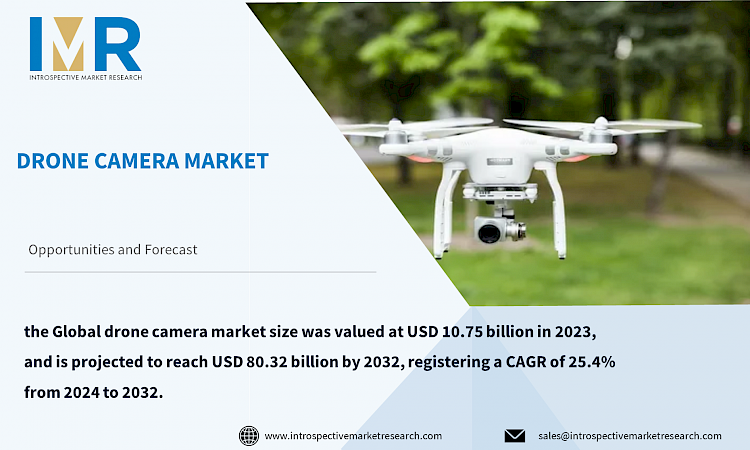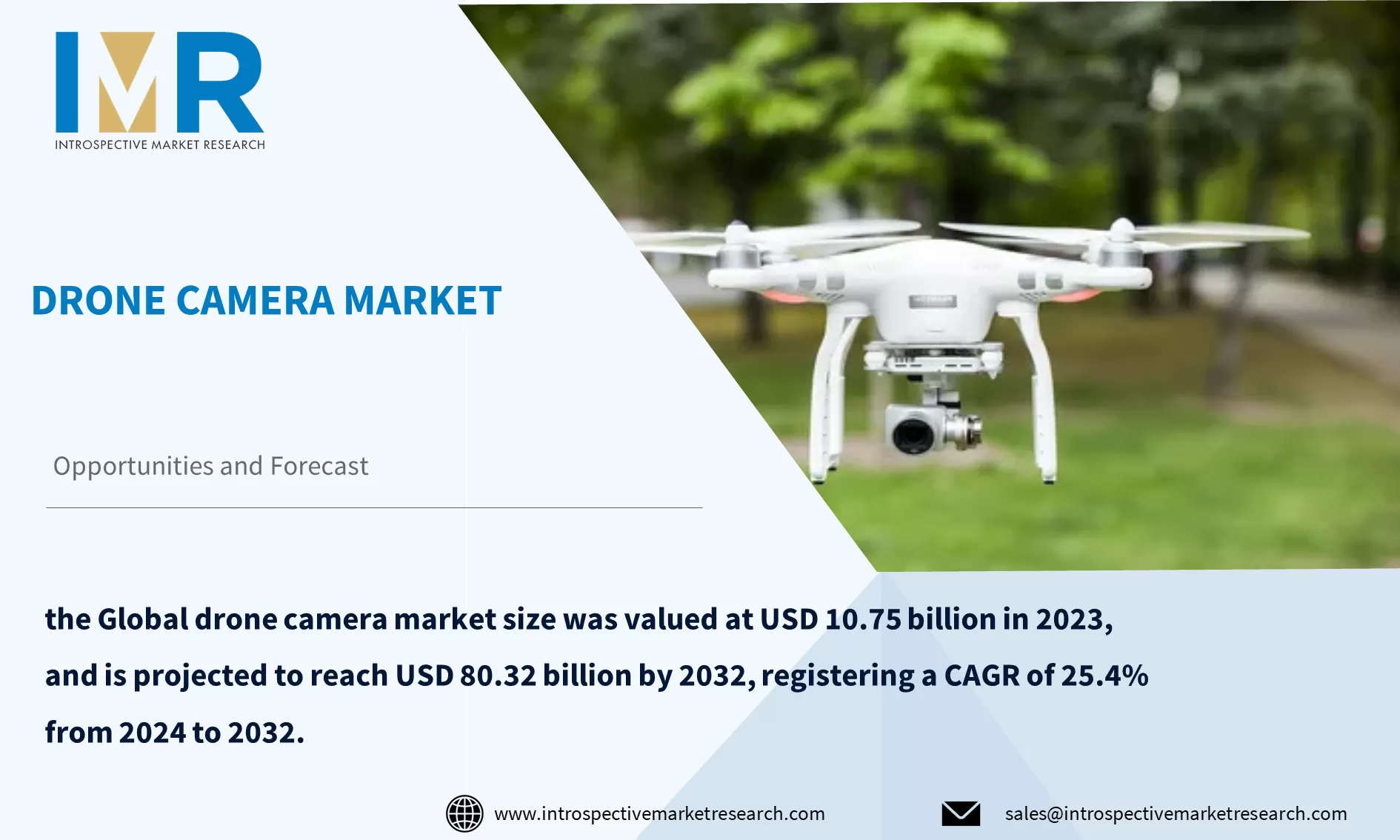
According to a new report published by Introspective Market Research, titled, ?Drone Camera Market by Type, Product Type, Application, Resolution, End-user, Distribution Channel, and Region: Global Opportunity Analysis and Industry Forecast, 2024?2032,?
Global drone camera market size was valued at USD 10.75 billion in 2023, and is projected to reach USD 80.32 billion by 2032, registering a CAGR of 25.4% from 2024 to 2032.
The drone camera market in Global has witnessed substantial growth in recent years, due to its use in military services, photography and videography, and homeland security. A drone camera is a camera that is attached to an aerial vehicle or drone. It is equipped with high-quality cameras that allow photographers and videographers to capture stunning aerial shots and cinematic footage.
Drone cameras can assess the extent of natural disasters, such as earthquakes or floods, by capturing aerial images and videos. It can quickly and accurately survey large areas of land and create detailed maps for urban planning, construction, agriculture, and environmental monitoring. In precision agriculture, it helps farmers monitor crops, identify diseases, and analyse soil conditions. Drones can inspect bridges, power lines, pipelines, and other infrastructure more efficiently and safely to help engineers detect potential issues or damages.
The drones equipped with cameras offer unique perspectives and aerial views that were previously inaccessible. These have proven to be invaluable tools in sectors that act as a driving factor for this market. It can quickly and efficiently capture high-resolution images and videos of sites and do accurate mapping. Also, it aims to transport packages quickly and efficiently for delivering goods in congested and remote areas. It offers enhanced surveillance and monitoring capabilities, making them valuable tools in various security-related domains covering large areas and providing real-time aerial footage, making it easier to monitor borders and detect any unauthorized activities or breaches.
The high-resolution cameras can capture detailed images and videos of crops which allows farmers to assess the health and growth of plants on a much larger scale. This helps to manage and maintain targeted application of fertilizers, pesticides, and water resources resulting in cost savings and minimized environmental impact. It helps to detect issues like nutrient deficiencies, pests, or diseases at an early stage helping to improve crop health and maximize yields. Also, camera drones eliminates the need for manual inspections and helps to reduce time consumption due to manual monitoring which further leads to a reduction in labor cost required for monitoring.
The market expansion has been fuelled by the rising popularity of drone cameras among commuters for short-distance trips, coupled with advancements in technology that have made bike rentals more convenient and accessible through mobile apps and digital payment systems.
Global Drone Camera Market, Segmentation
The Drone Camera market is segmented based on Type, Product Type, Application, Resolution, End-user, Distribution Channel, and region.
Type:
HD (high definition) cameras offer superior image quality compared to SD cameras. They capture images and videos with higher resolution, clarity, and detail. This is essential for crop analysis, disease detection, and yield estimation. The superior image quality makes them highly desirable for various applications, including aerial photography, videography, surveillance, and inspection. These cameras are capable of capturing finer details, colors, and textures. HD Cameras are crucial for live streaming and broadcasting applications enabling the real-time transmission of high-quality videos, making them ideal for sports events, news coverage, and live events. It comes equipped with image stabilization capabilities that reduce the effects of drone movement and shaky footage.
End-user:
Drone cameras have become an integral part of modern military operations due to their ability to gather intelligence, conduct surveillance, and carry out missions with reduced risks. These are used for reconnaissance, target acquisition, situational awareness, and monitoring enemy activities. In this sector, there is a demand for high-performance cameras to capture long-range detailed and actionable intelligence with their superior resolution, and image quality in remote and congested areas. Military-grade drone cameras play a vital role in border surveillance, coastal monitoring, perimeter security, and protection of critical infrastructure. These cameras equipped with night vision and thermal imaging capabilities are required to capture at night, low light areas with stringent security and confidentiality measures to protect classified information.
Region:
The Asia Pacific region has experienced a significant increase in demand which is fuelled by the need for aerial photography, surveillance, inspection, and security. The significant growth in e-commerce platforms and delivery services resulted in the trend of drone delivery. Several governments in the Asia Pacific region provide incentives, subsidies, and favourable policies to consumers for the use of drone cameras in industries like agriculture overall resulting in increased production, and reduced damage. These are used for environmental monitoring, disaster management, and conservation efforts further boosting the demand for drone cameras and also capturing stunning visuals of diverse cultural heritage, scenic landscapes, and tourist attractions for attracting tourists.
Some of The Active Market Players Are-
- DJI (China)
- Orqa International (Crotia)
- AeroVironment (US)
- PowerVision(China)
- Parrot (France)
- Autel Robotics (China)
- Skydio (California)
- Delair (France)
- Ehang (China)
- Freefly (USA)
- Flyability (Switzerland)
- Insitu (Washington)
- Wingtra (Switzerland)
- Airobotics (Israel)
- JOUAV (China)
- Draganfly (Canada)
- Yuneec (China)
- Hubsan (China)
- Syma (China)
- Hindustan Aeronautics (India)
- Zen Technologies (India)
- RattanIndia Enterprises (India)
- Paras Defence and Space Tech (India)
- Info Edge (India)
- Aibotix (Germany) and Other Active Players.
Key Industry Developments
- In January 2024, DJI, the world?s leader in civil drones and creative camera technology launched FlyCart 30 (FC30) to the global market. This is a delivery drone. It can carry a 30 kg payload of 16 km
- In 2024, A drone start-up Garuda Aerospace launched a nano drone, Droni. Droni is a small-sized foldable quadcopter launched for the consumer photography and cinematography segment.
Key Findings of the Study
- Global drone camera market growth driven by urbanization, eco-awareness, and government support.
- E-bikes offer a significant opportunity for longer commutes and hilly areas.
- Docked-sharing systems ensure convenience, organized bike access, and user-friendly amenities.
- Cities like New Delhi stand out due to high urbanization, creating a strong demand for drone camera services.





